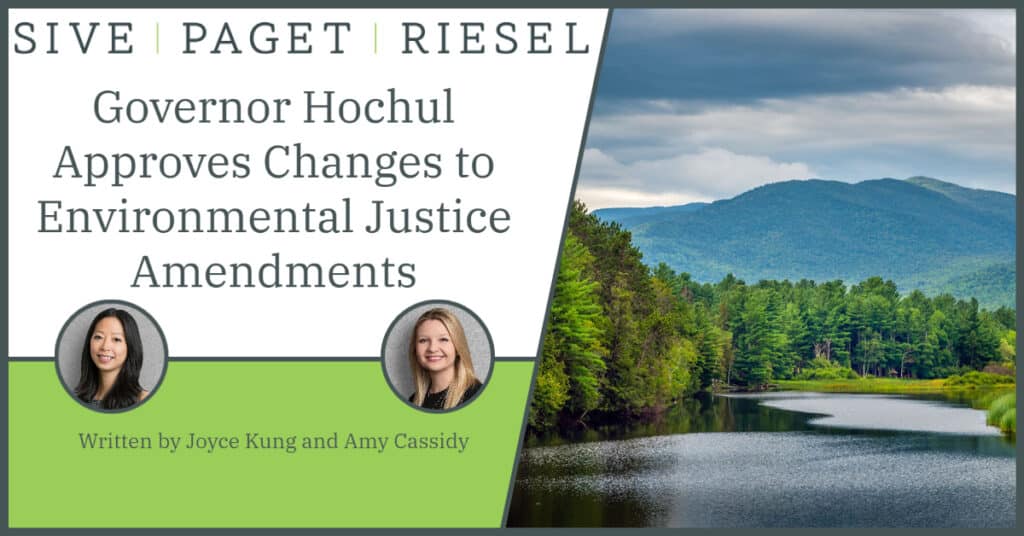Blog

Governor Hochul Approves Changes to Environmental Justice Amendments
On March 3, 2023, Governor Hochul approved the New York State Legislature’s “chapter amendment” (S01317/A01286) to the environmental justice law that was enacted in December 2022 (S8830/A2103-D). The original legislation amended the State Environmental Quality Review Act (SEQRA) process and the New York State Department of Environmental Conservation’s (NYSDEC) permit approval process to expressly incorporate environmental justice considerations, as discussed in greater detail in a previous SPR blog post. The 2023 amendment delays the effective date of the entirety of the original legislation, which will now go into effect December 30, 2024.
The 2023 amendment changed or clarified some aspects of the original legislation that revised the SEQRA process. For projects other than “minor projects,” the original legislation required that, in determining whether a project could have significant adverse environmental impacts requiring the preparation of an environmental impact statement (EIS), SEQRA lead agencies would have to consider whether the project may “cause or increase a disproportionate or inequitable or both disproportionate and inequitable pollution burden on a disadvantaged community that is directly or significantly indirectly affected” by the project. SPR’s previous post raised the potential confusion surrounding the term “minor project” in this context, because it is not a term used in SEQRA. The 2023 amendment removes the “minor project” threshold. The 2023 amendment modifies the term “a disproportionate or inequitable or both disproportionate and inequitable pollution burden” throughout the law in favor of the simpler term “a disproportionate pollution burden.”
In addition, the 2023 amendment strikes in its entirety the provision in the original legislation that required NYSDEC to include on the list of SEQRA “Type I” actions “actions which may cause or increase, either directly or indirectly, a disproportionate [and]/or inequitable . . . pollution burden on a disadvantaged community.”
The 2023 amendment also addresses NYSDEC permitting. The amendment narrows the range of NYSDEC permits for which an “existing burden report” must be prepared. Whereas the original legislation required an existing burden report for “non-minor projects” “that may directly or indirectly affect a disadvantaged community,” the 2023 amendment narrows this requirement to “applicable permits” that may contribute more than a “de minimis amount of pollution to any disproportionate pollution burden on a disadvantaged community.” An “applicable permit” under the 2023 amendments excludes general permits, and specifically only covers certain permits regarding water withdrawals, water pollution control, air pollution, liquified natural or petroleum gas, and solid and hazardous waste.
For existing applicable permits where a permit renewal or modification is sought, NYSDEC can elect not to require such a report “if the permit would serve an essential environmental, health, or safety need of the disadvantaged community for which there is no reasonable alternative.” In addition, the amendments provide that an existing burden report shall not be required for a permit renewal if such a report has been prepared for the same permit within the previous ten years.
The 2023 amendment requires that the scope of an existing burden report be developed by NYSDEC in consultation with the State Department of Health, following a minimum 30-day comment period on the scope. The permit applicant will then prepare the report consistent with the scope.
In deciding whether to issue a permit, the 2023 amendment specifies that NYSDEC should rely on an administrative record that includes comments from the disadvantaged community. NYSDEC cannot approve a new permit if a project will cause more than a de minimis amount of pollution to a disproportionate pollution burden on a disadvantaged community, or for permit modifications and renewals, a “significant increase” to the disproportionate pollution burden.
As was a concern with the original legislation, many of the terms and standards used in the 2023 amendments are not defined. For example, the law still does not explain the standard for determining if a pollution burden is “disproportionate.” It also does not define what constitutes a “de minimis amount of pollution.”